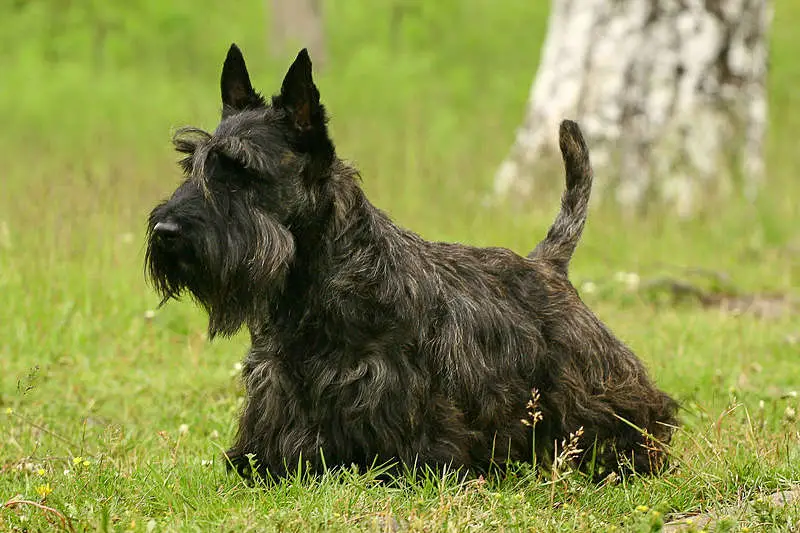Just about everybody knows the “Scottie,” what with its pin-pricked ears and its distinguished, bearded face – trademarks that have flashed across more than a few silver-screen (and small-screen) roles. These handsome terriers, often called “Diehards,” were the companions of quite a few British royals, U.S. presidents, and Hollywood stars and starlets, and remain common cultural images – including as a playing piece working its way around the “Monopoly” game board.

The Scottish Terrier dog breed
History
The Scottie is among a cadre of “highland terriers” hailing from Scotland, alongside the Skye, Dandie Dinmont, Cairn, and West Highland White breeds. They were “vermin”-hunting dogs by design, bred to chase rats, badgers, foxes, stoats, and the like on farms and deer parks. Scottish Terriers are often reckoned among the oldest of the highland terriers and, indeed, among the oldest distinct dog breeds in the British Isles, though exactly when “Scottish Terrier” came to specifically refer to this type isn’t clear. The American Kennel Club suggests the English king James I, who was born in Scotland, admired the Scottie and regularly gifted them during his reign in the late 16th and early 17th centuries.
As the Canadian Scottish Terrier Club notes, a dog enthusiast named W.W. Mackie recorded observations of highland terriers, including Scottish Terriers, in their native lands in the late 1870s. “The dogs varied widely in size, color, and ear carriage,” the Terrier Club writes, “but ever terrier man in the highlands of Scotland thought his own strain of dogs was the best and the truest Scottish Terrier.”
Mackie was among those who first exported the Scottish Terrier; by the 1880s the breed was well known in both England – which established a Scottish Terrier club before Scotland did – and the United States. Its popularity soared in the first half of the 20th century, when its celebrity owners included everyone from Humphrey Bogart to President Franklin Roosevelt, whose famous Scottie went by “Fala.” President Dwight D. Eisenhower welcomed not one but two Scotties to his White House household (“Caacie” and “Telek”).
The Scottish Terrier breed standard was significantly refined during this boom, as the rough-around-the-edges ratter was fine-tuned by English breeders for the show ring and the home hearth.
The mid-20th century – which also saw a Scottie prominently featured in the Disney film Lady and the Tramp – saw the summit of the Scottish Terrier’s popularity thus far, but it remains a common and cherished breed in the U.S. and around the world.
Appearance
Standing about 10 inches at the withers and weighing some 18 to 22 pounds, the Scottish Terrier is a sturdy, short-legged, short-backed, big-headed beast with particularly ample hair on the muzzle and the underbody. The shaggy beard, the sharp and erect ears, and the stubby ramrod tail are the defining hallmarks.
The coat – a double layer of coarse, wiry outer hair and plusher, denser undercoat – comes in a wide range of colors, the most classic of which is pure or grizzled black.
Personality and temperament
The Scottish Terrier exemplifies the stereotypical terrier mien: feisty, strong-willed, oozing confidence and energy. They are exceedingly loyal to their family and suspicious of strangers, a trait that recommends them as a watchdog. Their hunting/chasing instinct means they don’t always integrate well with cats, and they’re often territorial and even aggressive around other dogs, though early socialization can moderate that behavior. Besides hightailing it after cats and squirrels, Scotties also commonly express their heritage through enthusiastic digging.
Shedding and grooming
The Scottish Terrier, which is not a heavy shedder, should be brushed a few times a week. The character of the double coat can be maintained with hand-stripping (ideally) or clipping.
Health and lifespan
A healthy Scottish Terrier often lives 12 or 13 years old. The breed does historically suffer from certain genetic health issues, including von Willebrand disease, “Scottie cramp,” and craniomandibular osteopathy, though reputable breeders do everything they can to minimize their occurrence. Hip dysplasia and patellar luxation are other potential health problems to keep an eye out for.
Exercise needs
These “Diehard” dogs have an awful lot of energy and thus need plenty of playtime and exercise, though these needs can easily be satisfied with city/apartment living. They love to chase balls and other toys, and relish the stimulation of a (leashed) walk, though they’ll likely be quietly frustrated that they can never seem to go full bore on the squirrels, rabbits, and other chase-able quarry they run across on a trip or two around the block.
Training and intelligence
Scottish Terriers are brainy dogs, and like many brainy dogs they exhibit both a high capacity for and some healthy resistance to training exercises. The key is to be persistent, thus countering their definite stubborn and strong-minded tendencies, and to switch things up, which keeps them from getting bored with the same old routines. Exposing them to early to other dogs should help temper – at least somewhat – their feistiness toward their fellow canines.
